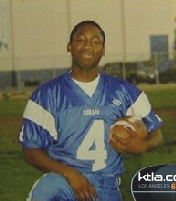

05/04/2012

KFI radio reporter Eric Leonard has been attending the trial of illegal alien Mexican Pedro Espinoza for the murder of high school student Jamiel Shaw (pictured) four years ago.
Leonard appeared on the John and Ken radio show during the 3pm hour on Thursday to explain the day’s testimony. (Listen — trial info starts at 1:20.) Of particular interest was Culver City detective Bryan Thompson who described an altercation with Espinoza in a police interrogation room. Espinoza jumped up and flipped the table over, saying something like, “Screw this” and taking a boxing stance against the officer. Thompson knocked him down with one punch and that interview was done.
Espinoza had been arrested earlier for threatening someone with a gun in a Culver City park over gangster stuff. Espinoza quizzed park visitor Sam Duran about his gang affiliation, asking “Where you from?” and Duran was able to escape when the Mexican was slow in pulling his revolver out of his pocket. This weapons possession was the crime that got Espinoza a few months jail time, after which he was let go and shot Shaw the following day.
The point is that Pedro Espinoza acted like a violence-crazed psycho in the presence of police. He was an illegal alien Mexican with a seemingly fanatical allegiance to the 18th Street gang. Even so, Espinoza was not deported, but was released onto the streets of Los Angeles, where he shot down Jamiel Shaw a day later.
The reason is Los Angeles’ own sanctuary city policy, Special Order 40 which protects even the worst illegal alien criminals and endangers American citizens.
In addition, I would like to know whether Espinoza had the BK (“blood killer”) tattoo behind his ear which identified him as a gang enforcer when the LAPD released him instead of sending him for deportation.
Jamiel Shaw Trial, KFI-AM 640, May 03, 2012
Prosecutors have presented evidence of the gang affiliation of the man on trial for the killing of high school athlete Jamiel Shaw, Jr. — as they try to explain the motive.
Pedro Espinoza could face the death penalty if he’s convicted and jurors agree the murder on March 2, 2008, was motivated by his gang ties.
One witness, a former Shaw neighbor, says as part of a police sting days after the killing, Espinoza smiled and said, “B.K. all day,” after being prompted about the murder.
“B.K.,” prosecutors explained, stands for “Blood Killer,” and again pointed out the tattoo with those initials behind Espinoza’s left ear.
Later, a man from Culver City described how he was confronted by Espinoza in a park a few months before the Shaw murder.
After Espinoza asked him ‘where are you from?’ — Samuel Duran said he watched Espinoza ride his bicycle through the park and confront others.
“That’s when he started throwing up his gang signs — eighteenth street,” Duran said.
Minutes later, Espinoza confronted Duran again, asked him if he had a problem, and tried to pull a handgun from his pocket.
“If it wouldn’t have gotten stuck he woulda pulled it out and used it,” Duran told jurors.
Then, the Culver City Police Department detective who interviewed Espinoza after the arrest for the Duran incident, said Espinoza snapped during an interrogation and challenged the detective — who stands at least a foot taller — to a fight.
“He stood up and flipped the table over,” said Det. Bryan Thompson. “He said — ‘man fuck this shit let’s go’ and took a fighting stance.”
“I struck him once in the face with my right fist,” Thompson said, and Espinoza screamed ‘18 motherfucker 18? repeatedly as he and two other officers tackled Espinoza and put on handcuffs.
The testimony about Espinoza’s gang ties is critical to the prosecution’s case: jurors must find a special circumstance true about Espinoza’s gang motive before a death sentence could be imposed.
During opening statements, L.A. County Deputy District Attorney Bobby Grace said Espinoza mistook Shaw’s red Spiderman backpack as a signal Shaw was a member of a rival Blood gang.
The judge has blocked much of the defense effort to show jurors Shaw may have also had gang ties. Jurors won’t get to see Blood gang tributes to Shaw posted online or hear about his gang-style street names.
But defense attorney Csaba Palfi has tried to suggest there was more to Shaw’s life than prosecutors presented — already, repeatedly questioning witnesses about whether Shaw was wearing more red clothing that day — that could be considered common Blood gang attire.
Five members of Shaw’s family in court Thursday wore bright red shirts and sweaters — no doubt making less certain the prosecutor’s efforts to keep the victim’s lifestyle out of jurors’ minds.
The L.A.P.D. homicide detective who investigated the Shaw case began testifying before the lunch break.
Det. Mark Holguin has described how he identified Espinoza from witness information.
– Eric Leonard at Criminal Courts